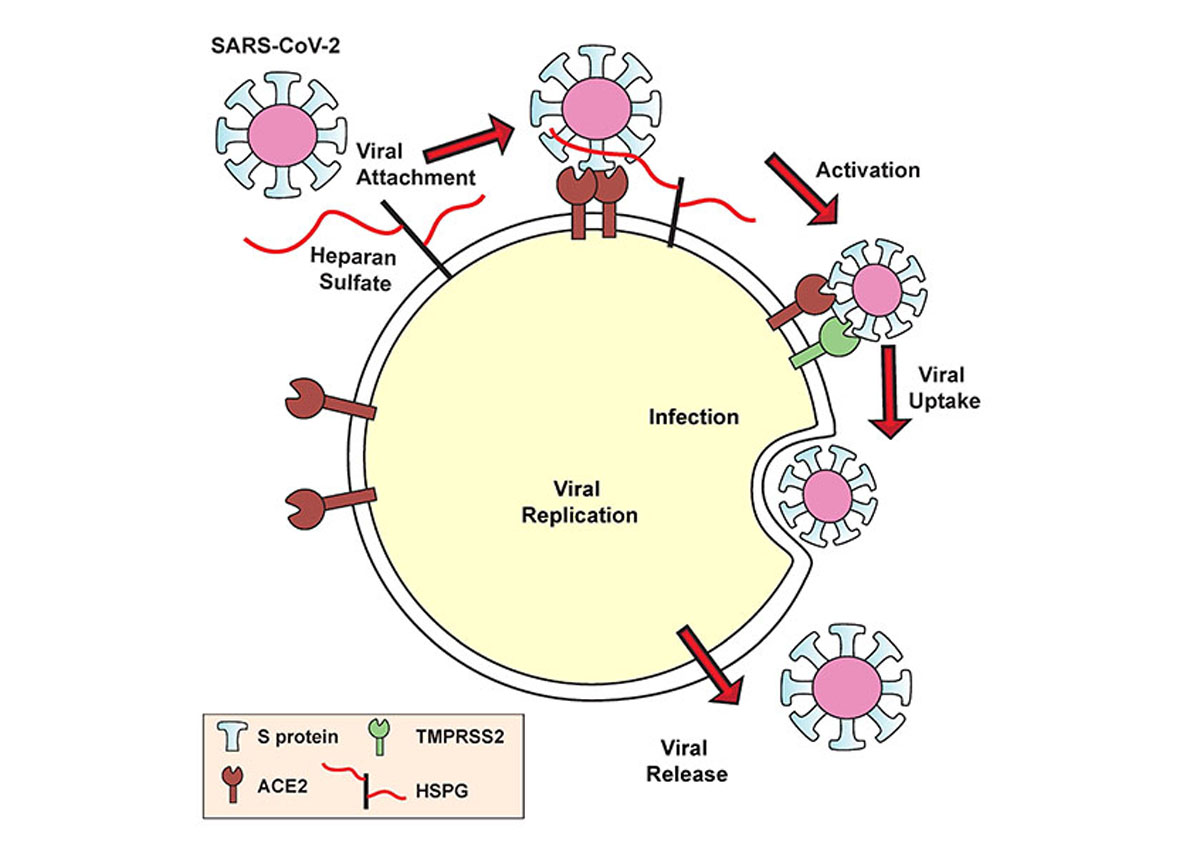
Researchers Discover SARS-CoV-2 Uses Heparan Sulfate to Get Inside Cells
September 16, 2020| |
At the onset of COVID-19, researchers have known that SARS-CoV-2 primarily uses the molecule ACE2 to enter the cells that line the lungs and establish respiratory infections. Finding a way to block this interaction between the virus and lung cells has become the goal of many research studies. Researchers at the University of California San Diego School of Medicine have discovered that SARS-CoV-2 cannot grab onto ACE2 without a carbohydrate called heparan sulfate, which is also found on lung cell surfaces and acts as a co-receptor for viral entry.
A study led by Dr. Jeffrey Esko, Distinguished Professor of Cellular and Molecular Medicine at UC San Diego School of Medicine and co-director of the Glycobiology Research and Training Center found the role that heparan sulfate plays in health and disease. They discovered that the SARS-CoV-2 spike protein binds to heparin, a form of heparan sulfate. The team also uncovered the exact part of the SARS-CoV-2 spike protein that interacts with heparin — the receptor binding domain. When heparin is bound, the receptor binding domain opens up and increases binding to ACE2. The virus, they found, must bind both heparan sulfate on the cell surface and ACE2 in order to get inside human lung cells grown in a laboratory dish.
The team introduces a potential new approach to preventing and treating COVID-19. They showed two approaches that can reduce the ability of SARS-CoV-2 to infect human cells cultured in the lab by approximately 80 to 90 percent. The first approach involves removing heparan sulfate with enzymes, while the second one uses heparin as bait to lure and bind the coronavirus away from human cells. Heparin is already a widely used medication to prevent and treat blood clots. The team found that enzymes that remove heparan sulfate from cell surfaces prevent SARS-CoV-2 from gaining entry into cells. Likewise, treatment with heparin also blocked infection.
For more details, read the article on UC San Diego Health.
| |
You might also like:
- Most Comprehensive Map of SARS-CoV-2 Genomic Structures Now Published
- Researchers Discover Vulnerability in SARS-CoV-2
- Study Finds SARS-CoV-2 Has Six Strains
Biotech Updates is a weekly newsletter of ISAAA, a not-for-profit organization. It is distributed for free to over 22,000 subscribers worldwide to inform them about the key developments in biosciences, especially in biotechnology. Your support will help us in our mission to feed the world with knowledge. You can help by donating as little as $10.
-
See more articles:
-
News from Around the World
- ANU Book Presents Stories of Communicating Science in 39 Countries
- FAO Reports Lack of Progress in Achieving SDG
- Research Reveals New Insights to Advance Cassava Breeding
- Massive-scale Genomic Study of Almost 80,000 Accessions Reveals Wheat Diversity
- Gene Editing Produces Livestock ‘Surrogate Sires' Successfully Made Fertile
- PH Government Grants GM Corn Seeds, Farm Inputs to Farmers Association's Model Farm
- Research Team Lays Foundation for Crops with Resistance to Combined Climatic Stresses
-
Research Highlights
- cry1Ab Transgene Segregation Patterns of GM Maize Documented
-
Plant
- Research Pinpoints GDSL Esterase/Lipase Protein Vital for Anther and Pollen Development
- CRISPR-Cas9 Elucidates Seed Shattering Reduction during Rice Domestication
-
Health
- Study Finds COVID-19 Virus Remains in Stool Samples
- Researchers Discover SARS-CoV-2 Uses Heparan Sulfate to Get Inside Cells
-
Read the latest: - Biotech Updates (November 12, 2025)
- Gene Editing Supplement (October 29, 2025)
- Gene Drive Supplement (February 22, 2023)
-
Subscribe to BU: - Share
- Tweet

